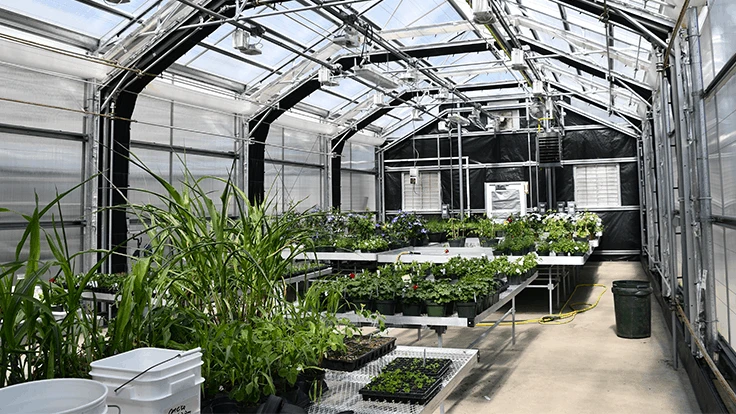

The many methods of controlling and manipulating plant growth during the young vegetative period, whether by direct contact (i.e. pinching) or environmental control, are too numerous to list here. Historically, indoor floriculture farmers have often found going the chemistry route the path of least resistance.
We are referring, of course, to plant growth regulation (PGRs) formulations. For decades, these now-largely off patent actives have been greenhouse growers’ primary means of ensuring the plants they produce are short and compact, and flower (or, in most cases, don’t) in a timely fashion.
The successful (and safe) use of these practical specialty chemistries touches every aspect of the green industry product cycle: growers who apply them can fit more plants on benches and in greenhouse blocks, as well as in each pallet or shipment, and logistics companies can haul more plants at a time. And retailer and customer both get an easier to handle, perfectly timed flowering plant to sell or take home.
Let’s take a quick look at what Extension researchers are sharing of late on plant growth regulators.
Research perspective
Uttara Samarakoon, PhD., is an assistant professor and coordinator in the nursery and greenhouse program on Ohio State University’s ATI campus in Wooster, Ohio. Conducting her research and lab courses in a range of state-of-the-art greenhouses dotting the rural satellite outpost about 45 minutes north of the main Columbus campus, Samarakoon has done quite a bit of evaluation around PGRs and their use in commercial greenhouse floriculture.
“Most of the (popular) active ingredients for greenhouse growers are the inhibitors of gibberellin synthesis,” she says. “Gibberellins are plant hormones that are mainly responsible for cell elongation. We’re talking about things like daminozide, chlormequat chloride, paclobutrazol, uniconazole, ancymidol and flurprimidol.”
She adds that ethephon is another active ingredient favored among commercial greenhouse operations. It differs from the gibberellin inhibitors in that its active ingredient actually breaks down within the plant tissue, releasing ethylene to slow down vegetative development.
Asked her top tip for PGR application timing, she stresses that growers should get PGRs on when plants are small.
“PGR applications for plant height control work well when plants are actively growing, because you cannot make an already stretched plant shorter,” Samarakoon says. “You can only control future stem elongation.”
She also emphasizes growers read and closely follow all PGR product labels. Often the most accurate information can be found right there on the manufacturer’s product label.
“Efficacy of applications relies on various factors, including following proper practices during application, such as ensuring uniformity of the application, applying only on early morning or cloudy days (not in direct sunlight or when supplemental lights are running), applying when the leaves are dry and following the label recommended rates and application methods (spray, drench, or sometimes both),” Samarakoon says.
Something else to keep in mind is that, like many agricultural inputs, more is not always better when it comes to PGRs.
“Many of these compounds can cause phototoxicity, if applied above recommended rates,” she says.

Research findings
Extension specialists Joyce Latimer of Virginia Tech University and Brian Whipker of North Carolina State University recently published a handy guide for ornamental growers interested in applying PGRs.
The study review “Selecting and Using Plant Growth Regulators on Floriculture Crops” is a one-stop shop resource for fitting PGRs into a greenhouse production system.
Once a grower decides to deploy PGRs instead of the other methods available through environmental and input control, choosing the correct active ingredient becomes crucial. However, growers must first consider which type of vegetative development they intend to control, or slow.
Want to hamper shoot growth? You are probably going to want a growth retardant. Trying to increase plant branching for enhanced cutting production? Sounds like a “chemical pincher” might be what you’re looking for. Looking to enhance or even sync up flower initiation? A PGR with chlormequat chloride or gibberellic acid is preferred.
Also, when selecting a PGR, keep in mind that most of the widely applied actives in the greenhouse market are currently off patent, so there are a myriad of brand names and formulations available today.Latimer and Whipker also emphasize that growers should carefully read product labels prior to making an application. Make sure you answer these key questions, and of course always follow the label for mixing and application guidelines:
- Is the chemical or active ingredient labeled for the crop you wish to treat?
- Is the active labeled for use inside a greenhouse or other growing structure?
- Are there any side effects, such as phytotoxicity?
- Are there label warnings for the effect on flowering?
The research duo also has useful suggestions on application timing, advising growers look at the label closely for information on timing of applications and plant condition at the time of application.
And make sure those applied molecules stay in close contact with plant tissue surfaces. For maximum uptake to be achieved, Latimer and Whipker advise the chemicals must remain in contact with plant tissues for as long as possible.
In closing, Latimer and Whipker surmise that “the multitude of variations possible in application methods, cultivar and species grown, and growing conditions makes it impossible to recommend specific product rates for all operations. Use the product labels and the appendix as resources for the use of PGRs on a variety of crops. Use the lower of suggested effective rates for starting your own trials.”

Explore the February 2021 Issue
Check out more from this issue and find your next story to read.
Latest from Greenhouse Management
- Grant awarded to test western U.S. wood species for use as wood fiber potting substrate
- Pennsylvania Horticultural Society announces 2025 Gold Medal Plant winners
- Oasis Grower Solutions announces new Southeast territory sales manager
- How to reduce labor in greenhouse vegetable production
- A nation of gardeners: A history of the British horticulture industry
- Last Word with Angela Labrum, Bailey Nurseries
- Iowa plant supplier Plantpeddler building retail complex
- This month's Greenhouse Management magazine is about native plants and sustainability








